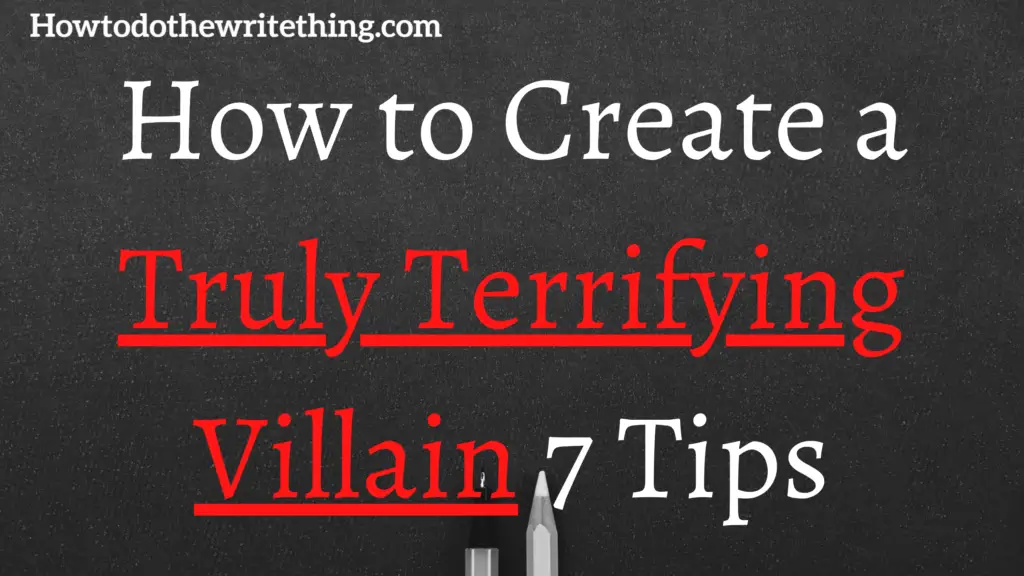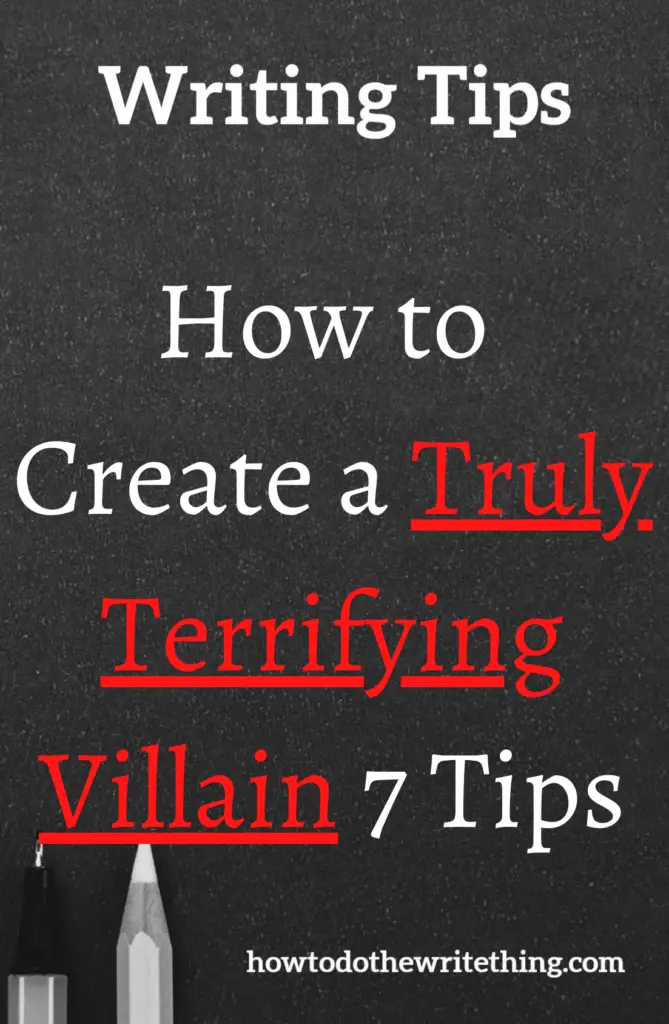
How to Create a Truly Terrifying Villain
What in a villain character is truly terrifying? Are there sure-fire ways to create a villain and know that it will scare our reader?
Hopefully, these tips will help you do just that.
Give the villain strength where the main character is weak.
Villains really start to become terrifying to a reader when they continually put our beloved main character into a constant state of lose-lose situations.
Instinctively, we want there to be a healthy give and take scenario in all our relationships in life, but when you put a person in the case where they always take and never give back what happens?
We instantly feel negative feelings towards that character. We feel that it is unfair. We start to feel worried for our main characters when the villain appears on the scene because we know inevitably our main character is going to lose something or someone they hold dear.
We feel this because we personally don’t want to lose someone or something we hold close to at heart.
Leave mystery for audiences to feel the fear of the unknown.
One of the best tools for creating a truly scary villain is making use of the fear of the unknown.
People who are afraid of the dark are not normally afraid of darkness. They are afraid of what might be lurking in the darkness. It’s the unknown factor.
Our overly stimulated imaginations run wild with all the horrifying possibilities of what might await us.
Think about dark water.
A clear swimming pool looks awesome because we can look through it and see whether there is danger or not, but put us on a plank with nothing but a deep blue ocean beneath us of never-ending mysterious peril, and all of the sudden we are hitting the fear of the unknown button.
Do this with your villain. Don’t reveal your villain for a good part of the story. Make your reader’s imagination run wild with all the possibilities so that they feel the fear of the unknown.
Think about Harry Potter and his main villain Voldemort.
Did you realize we don’t see his true form until around book 4?! (If I have it correctly, which correct me if I’m wrong here, but he doesn’t take his true villain form until book 4. He shows many strange mysterious forms before that.)
That’s some serious use of the fear of the unknown. He’s a lurking shadow that directly affects our main character’s life in terrible horrible ways for his entire life before we even really see him once.
Also, Rowling uses a ton of character dialogue to build up this mysterious Voldemort.
It’s like talking to friends and family about a horrible person, thing, or monster for a long time without ever experiencing it. We can be easily terrified by what people say about a person even if we never run into them ourselves.
By what people say we may never want to run into them.
And think about when a door or inanimate object moves in your house when you’re all alone. It’s creepy. Is not scary because the door moved, it’s scary because you don’t know why it moved at first. (Then you see your cat pop its head from behind the door and you breathe a sigh of relief.)
Don’t give the villain’s motives away at first.
Don’t give the villain’s motives away too soon (or maybe at all.)
This plays on the fear factor. When a reader sees a character do something horrid they instantly want to know why. “Why would anyone do such a thing?!” Is something they might be falling out thinking.
Keep that feeling there, planted in their mind for as long as you can. It helps keep curiosity (which keeps the reader reading.) It also is a good way of making the villain more terrifying. We continue to feel horror and dissatisfaction as our minds can’t fathom why the character would do such a thing or who sent the creature to do such a thing. Internally we are dying to know why!
When you finally do reveal the villain’s motives it can be a strong emotional connection moment for the reader and anchor their feelings into the story to see it through.
Want to get paid to write? Check out Writing Paychecks
- There is a simple method over 30,000 people use to get paid for freelance writing online.
- Opportunities can get started in just minutes a day, all from your home couch.
- It’s easy to get started! No previous experience or degree required to start.
- Exclusive job listings for writers, updated daily.
Check out Writing Paychecks to see if you can start getting paid to write today.

Make the villain’s horrible acts hollow to the main character.
Oftentimes we follow the hero around as they try to save everyone in their path that’s innocent and in danger.
Most times they are saving people from monsters and Sudo villains that are greedy and like to abuse people.
But then they run into someone or something that is truly terrifying because our main character can’t figure out why they are doing it and there seems to be no motive or purpose as to why the villain would do such hideous things.
This is key to some terrifying villains M.O.
The longer you can keep your main character in this state and the more the reader believes it the more daunting the villain becomes as an adversary to stop.
When you understand your enemy’s motive it’s almost easier to figure out how to stop them. Until that point, it serves as a constant source of tension that the reader wants to resolve.
Defeat your main character.
This can be done in two ways.
If you’re writing a tragedy the hero dies. They don’t win. It doesn’t end happily per se.
So it’s inevitable that the hero will die whether they beat the villain or not.
If you’re not writing a tragedy then make your hero lose loved ones along the way. Make them lose battles. And most importantly make them lose so bad to the main villain at least once that we as the audience actually for a moment question whether or not you are writing a tragedy.
Make the main character lose much and we will feel more for the main character and feel fear when the villain is around because we know the stakes are high and no one is safe.
Use deception to solidify feelings of terror for your villain.
One of the best tools for creating a feeling of terror for the reader is deception. And don’t get me wrong, I’m not saying lie to your reader. Do this instead.
I don’t know if you have ever met a person like this before, but it goes like this:
You meet them, they are nice, funny, and charismatic. They mirror your body language. They listen really well. You think they are genuinely nice and interested in you and then they walk away and you overhear them say something really nasty about you behind your back to their friend.
That’s deception. And some really terrifying villains do this with characters for sinister reasons.
They make them feel safe, secure, and loved only to get them to let their guard down.
They manipulate them with feelings of care so they can get what they want out of them.
It is truly painful to experience in real life, and when you see it happen to a character on the page you might find yourself audibly screaming out, “No! Don’t get in their car! Oh no! I liked that character so much! Uh! Why?!” (If you can’t tell, I’ve been there.)
This is done really well when you create a character that the audience will love and then use the deceptive or nasty villain to kill them off.
Make it so the villain has nothing to lose.
One trick that works really well is using the contrast between the main character and villain of what they each have to lose.
When we create a lot for our main character to lose this helps the audience to feel the weight and fear of loss for the main character. This becomes exponential if we are able to make our audience believe that our hero has everything to lose while our villain has no risk of loss.
The more we reveal that the villain has the potential of loss the more we feel less afraid for the main character and the less fear we feel towards the villain.
The potential of loss for the villain makes them look weaker. We start to see the tides turning as we see the villain panic to not lose what they’ve gained or want to keep.
Enjoying How to Create a Truly Terrifying Villain? Take a moment and consider sharing this social-friendly image to say thanks and feel free to comment with your thoughts below! 🙂


Want to get paid to write? Check out Writing Paychecks
- There is a simple method over 30,000 people use to get paid for freelance writing online.
- Opportunities can get started in just minutes a day, all from your home couch.
- It’s easy to get started! No previous experience or degree required to start.
- Exclusive job listings for writers, updated daily.
Check out Writing Paychecks to see if you can start getting paid to write today.



That’s all for the moment.
Hope this helps!
Happy writing!
Another Post you Might like:
Mythical Creatures | 7 Tips on How to Write Mythical Creatures
Other Popular Posts you might enjoy:
5 Tricks How to Hide Your Villain Right Before Their Eyes
10 Tips How to Write Villains that Play Mind Games with Their Victims
4 Tips How to Write your Character Hitting Rock Bottom
10 Toxic Bad Habits That’ll Crush Your Fictional Character’s Relationships
How to Write From Your Villain’s Mind.
How To Write 4 Scenes That Reveal Who Your Character Is Seamlessly
Psychopath: How to Write The Perfect Psychopath
8 Tips How to Write the Perfect Sociopath
Other Resources You Might Enjoy:
How to Start a Blog in 11 Simple Easy Steps in 2020
How to Write a Book: 32 Tips | Your MASSIVE Guide How to Write a Book
Interested in starting a blog of your own? Check out Bluehost.
Check out these FREE trial resources from Amazon for when you work from home (or are stuck at home 🙂 ) As an Amazon associate, if you do sign up or buy anything using Amazon links from our site we make a commission at no extra cost to you.
Free Prime Membership Trial:
Try Amazon Prime 30-Day Free Trial
Try Prime Discounted (Free Trial)
Get Unlimited Music for Free (30-day free trial):
Free Baby Registry:
Shop Amazon – Create an Amazon Baby Registry
Make your Free Amazon Wedding Registry:
Create an Amazon Wedding Registry
Enjoying How to Create a Truly Terrifying Villain? Take a moment and consider sharing this social-friendly image to say thanks and feel free to comment with your thoughts below! 🙂


Make sure your posts are readable. Use this readability score check
Want to check out a writer’s community to test your writing and get feedback?
We hope you enjoyed: How to Create a Truly Terrifying Villain!

